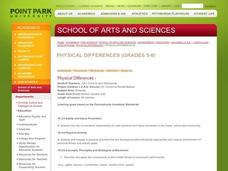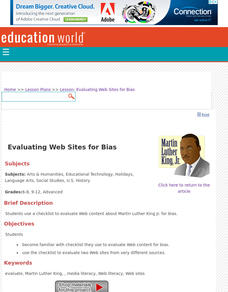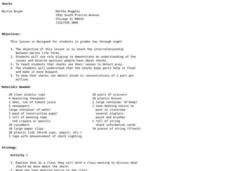Curated OER
Chops and Axes - A Jazz Talk Show
Students listen to, analyze, and describe music. They gain an understanding of music in relation to history and culture.
Curated OER
American Foreign Policy Since World War II (The Cold War)
Students identify and interpret some key figures and major events during the Cold War era, including the Korean War, Vietnam, Cuban Missile Crisis, Bay of Pigs Invasion, and the United States and China Cold War Relations. They also play...
Curated OER
Using Words to Work Things Out
Students recognize a problem and how to resolve it. In this instructional activity, students listen to The Hating Book and discuss the events of the story. Students answer comprehension questions and relate to their own experiences....
Curated OER
Revolutionary War
Students identify and research significant people, causes, and primary documents of the U.S. Revolutionary War. They create a class Revolutionary War web using Inspiration computer software, write a journal depicting three days in the...
Curated OER
"Four" Goodness Sake
Fourth graders recognize that ethnicity, religion and geography are reflected in the food choices we make. For this food choices lesson, 4th graders discuss different types of food from different places. Students compare a menu to the...
Curated OER
Diversity
Students access prior knowledge of the five senses and relate to students with disabilities. In this people with disabilities lesson, students research and use a Venn diagram to compare and contrast famous people and their...
Curated OER
Relationship Between Addition and Subtraction
Students are taught how to add and subtract and use number sense to solve basic math problems. In this addition and subtraction instructional activity, students are being taught using theories from different philosophers in education....
Curated OER
Playing with History
Students consider the elements that make computer games compelling, then use these elements to develop game 'narratives' based on historic events.
Curated OER
Cloud in the Classroom
Students describe the relationship between animals and humans. In this biology instructional activity, students research about the history of horses in America. They present a mock news broadcast about their research.
Curated OER
It's Off to Work We Go
Students reenact what finding a job was like in the 1900's and model their actions after Milton Hershey. In this history lesson, students create business cards, and conduct mock interviews for jobs that would have been...
Curated OER
Language Recognition and Language Families
Students debate the pros and cons of bilingualism in the United States and in the classroom. Students investigate how language reflects and influences culture, and focus on how to make language acquisition easier for students.
Curated OER
Wilson Stands Alone in His Plan for World Peace
Students study the Fourteen Points. They examine motives behind Wilson's Fourteen Points and why most of them were rejected by France. They answers questions concerning primary resources (casualty list and before and after...
Curated OER
Milton Hershey and the Qualities of a Hero
Middle schoolers create a classroom mural that features heroes. In this Milton Hershey lesson, students discuss the qualities Hershey had that made him a hero. Middle schoolers then identify other heroes and design a classroom mural of...
Curated OER
A Picture is Worth a Thousand Words: How to Analyze a Historic Photograph
Students analyze historical images. In this primary source analysis lesson, students examine an photograph of Hershey, PA from the 1920's. Students collaborate with one another and their instructor to note the details in the photograph...
Curated OER
Evaluating Web Sites for Bias
Students become familiar with checklist they use to evaluate Web content for bias. They use the checklist to evaluate two Web sites from very different sources.
Curated OER
True Crime
Students discuss reasons for the increase in violent crime across the country. They examine the factors to which increases in violent crime can be attributed. Students brainstorm consequences of the forces that have led to the decrease...
Curated OER
Sharks
Students delve into a study of sharks. In this biology lesson plan, students explore how sharks use their senses to detect prey and understand that the sharks body parts help it float and make it more buoyant.
Curated OER
Nutrients
Fourth graders understand the important nutrients in food and the value of each. In this nutrients lesson, 4th graders complete a chart giving examples of foods that contain that nutrient and a definition of the nutrient. Students...
Curated OER
Cacao Tree Geography
Students use a map to learn about where chocolate comes from. In this lesson on the cacao tree, students locate various regions where the cacao tree grows. They will discuss why the cacao tree grows more favorably in particular climates...
Curated OER
Deforestation
Students identify the different tropical rainforests in the world using a map. In this ecology lesson, students describe the different methods of deforestation. They create a memo and present it to class.
Curated OER
Mining an Ore
Students investigate how to determine the percent composition of a mineral in an ore. In this mining an ore lesson plan, students use chocolate chips cookies to represent an ore and they remove precious minerals (the chocolate chips)...
Curated OER
Rainforest Relationships
Young scholars provided with opportunities to explore the animals and plant life that coexist in the various layers of the tropical rainforest. They appreciate the diversity of life in each layer. Students write a report on a particular...
Curated OER
Hello My Name is . . . Helvetica
Learners play various games to help create a classroom community. In this name recognition lesson, students combine their name recognition skills with newly learned art and geometric vocabulary. First learners discover vocabulary that...
Curated OER
Can You Hear a Story?
Learners listen to, analyze, and describe music. They explain relationships between music, the other arts, and disciplines outside the arts.























